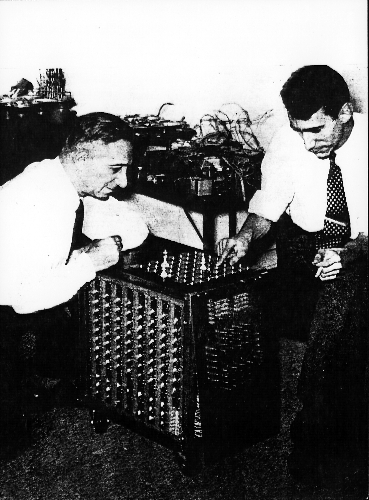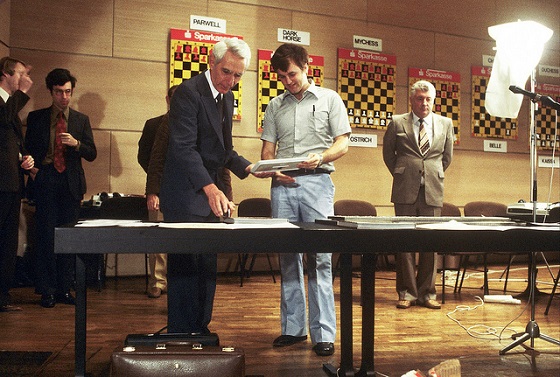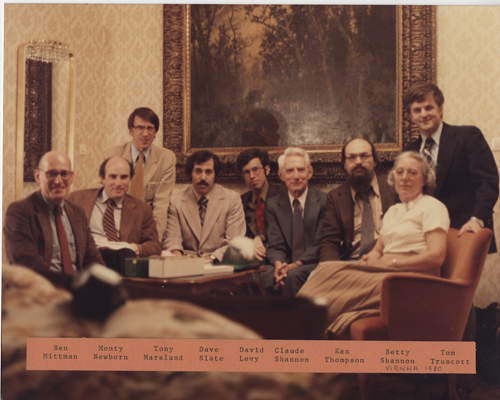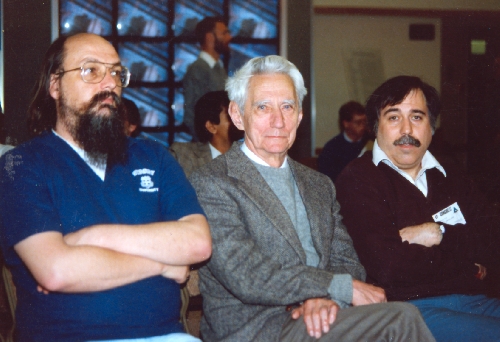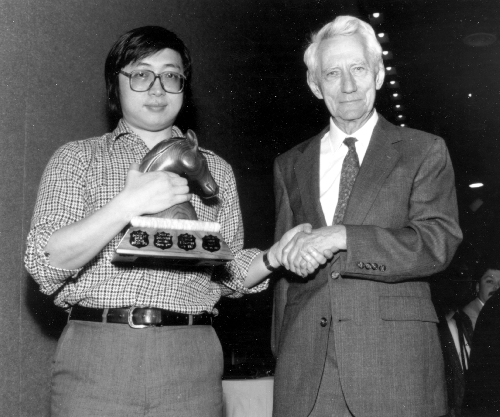Claude Shannon
Home * People * Claude Shannon

Claude Elwood Shannon, (April 30, 1916 – February 24, 2001)
was an American electrical engineer, mathematician and researcher from MIT and since 1941 Bell Laboratories. One of the pioneers of the information theory .
In 1949 Shannon published a groundbreaking paper on computer chess entitled Programming a Computer for Playing Chess [2] . It describes how a machine or computer could be made to play a reasonable game of chess. His process for having the computer decide on which move to make is a minimax procedure, based on an evaluation function of a given chess position.
Contents
Photos
Chess Automation
Quote of the text on the back on the photo, as given in ICCA Journal, Vol. 12, No. 4: [3] :
Dr. Claude E. Shannon demonstrating to Chessmaster Edward Lasker his (home-made) electric chess automation, build in 1949. The machine could handle up to six pieces, and was designed to test various programming methods. With one hundred and fifty relay operations required to complete a move, it arrived at the reply to an opponent's play in ten to fifteen seconds. It had built into it a random element, and as a result did not necessarily always make the same move when faced with the same position.
Computer pioneer Claude Shannon and chess champion Edward Lasker at MIT, ponder the
computational aspects of playing chess at Shannon's early relay-based chess machine [4]
WCCC 1980
WCCC 1980, Linz, Austria, Special guest Claude Shannon, David Levy left [5]
Chess pioneers in Sacher Hotel Vienna, Austria 1980: Ben Mittman, Monty Newborn, Tony Marsland,
Dave Slate, David Levy, Claude Shannon, Ken Thompson, Betty Shannon, Tom Truscott [6]
WCCC 1989
Thompson, Shannon, and Slate at the 6th WCCC Edmonton 1989 [7]
Claude Shannon awards Feng-hsiung Hsu, first prize for Deep Thought, Edmonton 1989 [8]
Shannon's Types
Claude Shannon categorized two types of search [9] :
- Type A - a brute-force search looking at every variation to a given depth
- Type B - a selective search looking at "important" branches only
Without the sense of alpha-beta, and inspired by the experiments of Adriaan de Groot [10] , Shannon and early programmers favored Type B strategy. Type B searches use some type of static heuristics in order to only look at branches that look important - with some risk to oversee some serious tactics not covered by the plausible move selector. Type B was most popular until the 1970's, when Type A programs had enough processing power and more efficient brute force algorithms to become stronger. Today most programs are closer to Type A, but have some characteristics of a Type B as mentioned in selectivity.
See also
Selected Publications
1938 ...
- Claude Shannon (1938). A Symbolic Analysis of Relay and Switching Circuits. Transactions of the AIEE, Vol. 57, No 12, Master's thesis 1940, Massachusetts Institute of Technology
- Claude Shannon (1948). A Mathematical Theory of Communication. pdf
- Claude Shannon (1949). Programming a Computer for Playing Chess. download pdf from The Computer History Museum
1950 ...
- Claude Shannon (1950). A Chess-Playing Machine. Scientific American, Vol. 182 (No. 2, February 1950), pp. 48-51. Reprinted in The World of Mathematics, edited by James R. Newman, Simon & Schuster, NY, Vol. 4, 1956, pp. 2124-2133. Included in Part B
- Claude Shannon (1953). Computers and Automata. Proceedings of the Institute of Radio Engineers Vol. 41, No. 10 [11] [12] [13]
- John McCarthy, Marvin Minsky, Nathaniel Rochester, Claude Shannon (1955). A Proposal for the Dartmouth Summer Research Project on Artificial Intelligence.
- Claude Shannon, John McCarthy (eds.) (1956). Automata Studies. Annals of Mathematics Studies Number 34, Google books, oldcomputerbooks.com
1980 ...
- Jaap van den Herik (1989). An Interview with Claude Shannon, September 25, 1980 in Linz, Austria. ICCA Journal, Vol. 12, No. 4
- Bob Herschberg, Jaap van den Herik (1989). Thank You, Dr. Shannon. ICCA Journal, Vol. 12, No. 4
- Neil J. A. Sloane, Aaron D. Wyner (1993). Claude Shannon: Collected Papers. IEEE Press, ISBN 0-7803-0434-9
2000 ...
- Ken Thompson (2001). CLAUDE SHANNON (1916-2001): FUNDAMENTAL CONTRIBUTIONS. ICGA Journal, Vol. 24, No. 1
- Jaap van den Herik (2001). CLAUDE SHANNON (1916-2001): THANK YOU. ICGA Journal, Vol. 24, No. 1
- Ben Mittman (2001). OBITUARY CLAUDE SHANNON (1916 – 2001): PERSONAL MEMORIES. ICGA Journal, Vol. 24, No. 2
- David Mindell, Jérôme Segal, Slava Gerovitch (2003). Cybernetics and Information Theory in the United States, France and the Soviet Union. in Mark Walker (ed.) (2003). Science and Ideology: A Comparative History. Routledge » Claude Shannon, Norbert Wiener, covers the 1951 Paris Cybernetic Congress
- Pamela McCorduck (2004). Machines Who Think: A Personal Inquiry into the History and Prospects of Artificial Intelligence. A. K. Peters (25th anniversary edition)
Forum Posts
- One hundred years ago by Steven Edwards, CCC, April 30, 2016
External Links
- Claude Shannon from Wikipedia
- Claude Elwood Shannon - Wikiquote
- The Mathematics Genealogy Project - Claude Shannon
- Details for Claude Shannon - Oberwolfach Photo Collection
- Ars Electronica - Codes & Clowns (2010/2011) – Flickr
- Shannon entropy from Wikipedia
- Shannon's source coding theorem from Wikipedia
- Shannon index from Wikipedia
- Shannon number from Wikipedia
- Shannon switching game from Wikipedia
- Remembering Claude Shannon (pdf)
Videos
- Claude Shannon demonstrates "Theseus" Machine Learning @ Bell Labs, YouTube Video
100th Birthday
- Claude E. Shannon 100th Birthday Celebration — Information Theory Society, IEEE
- Der Erfinder der Information | HNF Blog, April 29, 2016, Heinz Nixdorf MuseumsForum (German)
References
- ↑ Claude Shannon from Wikipedia
- ↑ Programming a Computer for Playing Chess (raw text)
- ↑ Photo of courtesy of Mrs. Shannon and Jos Uiterwijk, ICCA Journal, Vol. 12, No. 4, pp. 217. Quote of the text on the back on the photo
- ↑ Shannon and Lasker at Shannon's chess machine, ca. 1950 Gift of Monroe Newborn from The Computer History Museum
- ↑ Claude Shannon during the 3rd World Computer Chess Championship that was staged in the course of the Ars Electronica Festival 1980, credit: LIVA – Linzer Veranstaltungsgesellschaft mbH, Ars Electronica - Codes & Clowns (2010/2011) – Flickr
- ↑ Chess pioneers in Sacher Hotel Vienna, Austria, Gift of Benjamin Mittman, The Computer History Museum
- ↑ Thompson, Shannon, and Slate Photo by Monroe Newborn from A History of Computer Chess from The Computer History Museum
- ↑ Claude Shannon awards Feng-hsiung Hsu Photo from A History of Computer Chess from The Computer History Museum
- ↑ Claude Shannon (1949). Programming a Computer for Playing Chess. download pdf
- ↑ Groot, A.D. de (1946). Het denken van den Schaker, een experimenteel-psychologische studie. Ph.D. thesis, University of Amsterdam; N.V. Noord-Hollandse Uitgevers Maatschappij, Amsterdam. Translated with the help of George Baylor, with additions (in 1965) as Thought and Choice in Chess. Mouton Publishers, The Hague. ISBN 90-279-7914-6. (amazon)
- ↑ In Vadim Anshelevich (2002). A hierarchical approach to computer Hex. Artificial Intelligence - Chips challenging champions: games, computers and Artificial Intelligence, pdf, Vadim Anshelevich acknowledged Claude Shannon, who build an analogue Hex-playing machine using electrical resistor circuits, which was model in Anshelevich's program Hexy
- ↑ Hex is a special case of the Shannon Switching Game, from Jack van Rijswijck (2003). Search and evaluation in Hex. Technical report, University of Alberta, pdf
- ↑ Thomas Fischer (2009). Bridg-It – Beating Shannon’s Analog Heuristic. pdf
